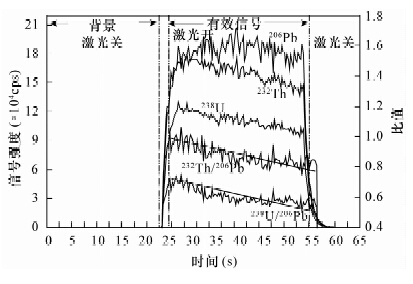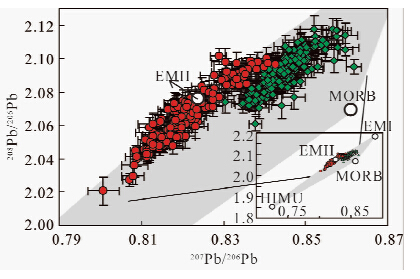Evaluation of Error Propagation in Lead Isotope Analysis of Ancient Melt Inclusions by LA-MC-ICP-MS
-
摘要: 目前应用LA-MC-ICPMS分析熔体包裹体Pb同位素, 由于没有同时测试U和Th的信号, 导致熔体包裹体Pb同位素的研究仅局限于中生代以来的样品。本文应用LA-MC-ICPMS分析了玻璃样品以及存在显著U-Th衰变影响的古老熔体包裹体的Pb同位素组成, 评价了U/Pb和Th/Pb分析误差对初始Pb同位素比值校正的影响。实验中以国际玻璃标样NKT-1G为外部标样, 采用“标样-样品-标样法”进行仪器漂移和质量歧视校正, 结果表明, 国际玻璃标样BHVO-2G、TB-1G的208Pb/206Pb和207Pb/206Pb分析精度优于0.30%(2RSD), 与推荐值的偏差小于0.30%, 然而232Th/206Pb和238U/206Pb分析结果显示了较大分散性(外精度约5.0%)。根据误差传递计算, 样品的年龄对初始铅的误差有很大影响。对于古生代以来的样品(年龄小于540 Ma), 即使测试的232Th/206Pb和238U/206Pb与真值偏差达到10%, 经过U-Th衰变校正后的Pb同位素比值与真值的偏差依然小于0.80%。因此本方法可以将熔体包裹体等地质样品的Pb同位素研究由新生代样品(年龄小于65 Ma)扩展到古生代样品。
-
关键词:
- 激光剥蚀 /
- 多接收器电感耦合等离子体质谱法 /
- 熔体包裹体 /
- 铅同位素 /
- 误差评价
Abstract: Determination of Pb isotopes in melt inclusions by Laser Ablation -Multiple Collector-Inductively Coupled Plasma-Mass Spectrometry (LA-MC-ICP-MS) is limited to samples formed later than Mesozoic because U and Th signals are not monitored. In this study, Pb isotopic compositions of two reference glasses and ancient melt inclusions which have undergone significant U-Th decay are determined by LA-MC-ICP-MS. The effect of the U/Pb and Th/Pb analytical errors on the calculation of initial Pb isotopic ratios was also evaluated. In the experiment USGS NKT-1G is used as the external calibrant and a standard-sample-standard bracketing method is used to correct instrument drift and mass bias. Analytical precisions of 208Pb/206Pb and 207Pb/206Pb of USGS standards, BHVO-2G and TB-1G, are better than 0.30% (2RSD) and both agree within 0.30% of the preferred values. However, 232Th/206Pb and 238U/206Pb ratios are highly variable and yield an external precision of 5%. Error propagation calculations indicate that the ages of the samples have significant effects on the errors of the initial lead isotopic ratios. For Phanerozoic samples that are earlier than 540 Ma, even the differences between the measured 232Th/206Pb and 238U/206Pb ratios and the real values reach 10%, yet the age-corrected initial lead isotopic ratios are still within 0.80% deviations relative to the real values. Therefore, the proposed method in this study can determine the lead isotopic compositions of melt inclusions in samples from Cenozoic to Paleozoic, expanding the geological application. -
“南海Ⅰ号”沉船1987年首次发现于我国广东省阳江市东平港以南约20海里处,是我国南宋时期的一艘沉船。据初步估算,整船文物大约6~8万件,以陶瓷器为主。近30年以来对于这些出水陶瓷器的相关研究并不多,有些文献只是对出水陶瓷器进行了简单介绍[1],或者以“南海Ⅰ号”为例分析我国水下文化遗产保护制度[2]、研究我国对外商贸[3]等等。作为中国的象征,陶瓷器研究一直处于重要地位,而对陶瓷器的科技分析,可获得传统考古学中无法定性、定量的资料,尤其是元素含量的差异所反映陶瓷器产地方面信息,而这些信息也是对传统考古学资料的补充或佐证。例如,何文权等[4]、杨益民等[5]、张茂林等[6]、朱铁权等[7]、吴隽等[8]众多学者利用微聚焦X射线荧光光谱仪(μ-XRF)对陶瓷器化学元素组成成分及含量进行测定,探索陶瓷器产地及制作工艺;拉曼光谱分析也被应用于古壁画、陶彩颜料[9]以及青铜器锈蚀产物[10]的分析研究,探索矿物或腐蚀产物的形成机理及保护等。
由于“南海Ⅰ号”出水陶瓷器产地的判别缺少相关数据的支撑,加之陶瓷器长期处于海底环境,受到海水侵蚀等诸多因素影响,发生了不同程度的病变,给陶瓷器保护及深入研究带来了困扰。因此本文选取“南海Ⅰ号”出水部分的陶瓷器样品,分为青白瓷、青瓷、绿釉陶三类,利用μ-XRF对这些古陶瓷标本进行了陶瓷胎釉化学成分分析测试,同时对陶瓷器的产地作出判断。由于绿釉陶表面腐蚀较为严重,本研究选用体视显微镜以了解绿釉陶的保存状况以及腐蚀状况,并利用拉曼光谱仪(μ-RS)对其腐蚀物作进一步分析,确定物相组成。此项研究结果对“南海Ⅰ号”出水陶瓷器研究有重要的参考价值。
1. 样品与实验方法
1.1 样品来源及外观特征
本项研究的样品一共15件,包括6件青白瓷样品、3件青瓷样品、6件铅釉陶样品。样品均由广东省海上丝绸之路博物馆提供。样品具体信息列于表 1。
表 1 标本外观描述Table 1. The exterior appearance of each sample标本编号 标本种类 外观描述 N1 青白瓷 表面刻花,釉色白中泛青灰;瓷胎较厚,胎灰白 N2 青白瓷 表面刻花,釉色白中泛青灰;瓷胎较厚,胎灰白 N3 青白瓷 表面印花,芒口,釉白中泛青,薄胎,胎洁白细腻 N4 青白瓷 釉色白中泛青,有弦文,胎较薄,洁白细腻 N7 青白瓷 花口,薄胎,釉色白中泛青,胎色洁白细腻 N22 青白瓷 口沿部分,釉色白中泛青,薄胎,胎质洁白 N12 青瓷 口沿及器壁部分,釉色青中发黄,器表划花,灰胎 N13 青瓷 口沿及器壁部分,釉色青中泛白,灰胎 N20 青瓷 器底部分,玉环圈足,釉色深青,器表划花,青灰胎 N5 绿釉陶 绿釉小罐,上面有土黄色,以及黑色斑点状的腐蚀 N8 绿釉陶 器底部分,灰胎,绿釉,表面附着灰色、黑色腐蚀物 N9 绿釉陶 口沿部分,印花,绿釉,表面附着灰色腐蚀物 N10 绿釉陶 口沿部分,印花,腐蚀物较少,但釉表面开始酥粉
N11绿釉陶 器底部分,绿釉,底部内标印花,
灰色腐蚀物,绿釉开始酥粉N16 绿釉陶 小瓶,口颈部分缺失,绿釉,表面锈蚀物很多 1.2 样品制备
为减少海水离子对后期成分以及元素含量的测定造成干扰,对实验样品采用纯净水浸泡、定期换水清洗的方式进行为期一年的脱盐处理。样品脱盐处理完毕、样品阴干后,用于实验。
1.3 分析仪器及测试条件
青白瓷、青瓷及绿釉陶的胎釉成分分析测试:实验在中山大学科技考古实验室进行,瓷器胎釉以及绿釉陶胎体的定量分析采用陶瓷标样法,绿釉陶釉面的定量分析采用无标样的基本参数法。采用的仪器为能量色散型X射线探针(EAGLE-μ型,美国EDAX International Inc),X光管管压40 kV,管流600 μA,真空光路,光斑直径300 μm,Mn Kα处的分辨率137.5 eV,死时间约20%,并采用Version 3.0的解谱软件进行样品定性定量分析。
绿釉陶样品以及腐蚀产物显微形貌观察:实验在中山大学科技考古实验室进行。采用的仪器为体视显微镜(SZX7型,日本Olympus公司)。
绿釉陶腐蚀物物相组成分析测试:实验在中山大学测试中心进行。采用的仪器为显微共焦拉曼光谱仪(InVi,英国Renishaw公司),氩离子激光器为光源,波长514.5 nm,物镜为50×,光斑尺寸1 μm,信息采集时间20~30 s,累加次数为2~3次。
2. 陶瓷器的化学组成和物相分析
相关研究表明,陶瓷器胎体的化学组成蕴含一定的窑口与产地信息[11]。本次瓷器胎釉共测量16个元素,包括8个主量元素、8个微量元素。具体分析结果列于表 2。
表 2 样品胎釉的XRF元素分析结果Table 2. Elemental compositions of each sample by XRF样品编号 含量(%) Al2O3 SiO2 TFe2O3 TiO2 MgO CaO Na2O K2O Cr Cu Mn P Rb Sr Zr Zn N1(胎) 21.00 72.30 0.85 0.16 0.25 0.22 1.67 2.55 19 72 277 277 193 62 254 131 N2(胎) 20.37 73.63 1.02 0.16 0.04 0.23 0.93 2.63 17 83 270 242 216 69 284 112 N3(胎) 17.85 73.57 0.55 0.12 0.69 0.91 2.39 2.92 - 0 309 271 381 67 85 68 N4(胎) 18.91 73.84 0.43 0.15 0.60 0.31 1.61 3.14 32 38 232 197 208 61 254 59 N7(胎) 19.00 73.29 0.92 0.15 0.66 0.45 1.86 2.68 11 21 582 272 411 62 130 28 N22(胎) 22.32 70.02 0.78 0.16 0.34 0.31 1.08 4.00 60 71 257 251 310 73 360 158 N1(釉) 14.89 66.50 0.79 0.13 0.63 12.78 0.91 2.37 - 14 1096 993 164 242 228 67 N2(釉) 17.50 67.72 0.72 0.15 0.28 9.28 0.75 2.58 - 28 692 639 164 170 240 78 N3(釉) 14.19 66.37 0.83 0.13 0.43 14.02 0.97 2.05 - 2 455 708 263 209 111 119 N4(釉) 17.61 65.67 0.30 0.13 0.43 10.58 0.84 3.44 - - 748 611 161 186 223 65 N7(釉) 13.85 70.18 0.61 0.13 0.01 8.56 1.74 3.92 15 8 738 723 396 194 88 21 N22(釉) 17.87 64.64 0.72 0.13 1.03 9.36 0.86 4.41 - - 703 1020 224 167 252 96 N12(胎) 15.45 75.59 2.08 0.53 0.04 0.21 1.75 3.35 97 7 292 210 308 53 247 91 N13(胎) 19.12 72.89 1.65 0.26 0.55 0.19 1.75 2.60 34 8 304 253 160 68 173 27 N20(胎) 13.32 78.30 1.73 0.45 0.70 0.24 1.36 2.90 130 37 460 232 245 65 302 95 N12(釉) 12.01 67.88 1.29 0.31 1.67 12.34 0.95 2.54 - - 2716 1498 202 376 273 154 N13(釉) 15.85 71.58 0.74 0.24 1.13 4.38 0.71 4.38 - 43 2395 1265 201 222 172 173 N20(釉) 12.35 61.89 1.24 0.28 2.38 16.28 1.57 3.01 - 26 2437 2875 187 719 269 162 N5(胎) 23.20 65.76 2.32 0.66 1.08 0.32 2.65 3.00 19 162 386 215 206 129 286 149 N8(胎灰色) 26.81 63.28 2.06 0.88 0.73 0.29 1.58 3.39 42 36 557 388 207 104 238 65 N8(胎) 23.91 65.71 1.84 0.70 0.91 0.32 2.35 3.27 56 47 449 288 212 94 297 116 N9(胎) 23.46 65.44 2.30 0.66 1.28 0.48 2.53 2.85 34 284 489 347 176 141 266 100 N10(胎) 21.82 67.29 2.49 0.63 1.46 0.31 2.53 2.47 41 97 458 279 184 99 212 102 N11(胎) 24.57 65.37 2.50 0.70 0.85 0.38 1.57 3.04 25 16 476 274 223 151 237 132 N16(胎) 24.23 65.27 2.45 0.67 1.03 0.36 2.00 2.99 37 135 589 378 192 110 321 92 注:分析结果中,主量成分含量单位为%,微量成分含量单位为μg/g,“-”表示此元素未检出。 2.1 青白瓷
本次分析测试的青白瓷样品共6件(编号N1、N2、N3、N4、N7、N22)。根据瓷胎薄厚、细腻度以及釉色等,将青白瓷分为两类:一类编号为N3、N4、N7,另一类编号为N1、N2、N22。其中第一类薄胎,胎质致密、洁白,釉色白中泛青;第二类胎体较厚,胎质较细,有少量气眼,釉色白中泛青灰。根据外形特征初步判断,第一类样品(N3、N4、N7) 可能产自江西景德镇湖田窑。基于以上信息,对6件青白瓷样品进行成分分析,分析结果列于表 2。
如图 1所示,青白瓷样品N3、N4、N7瓷胎的Al2O3含量均低于19%。N3样品瓷胎的Al2O3含量最低(17.85%),SiO2含量均在73%左右,K2O含量在2.68%~3.14%之间。对比样品N3、N4、N7瓷釉的CaO含量与Na2O、K2O含量,发现CaO含量要高于Na2O、K2O含量。
图 2是青白瓷样品N1、N2、N22瓷釉的氧化铁含量的柱状图,图中显示所有样品的氧化铁(TFe2O3)含量相对较低,均在1.0%以下,最低者仅为0.3%。相比之下,N1、N2、N22样品瓷胎中,Al2O3含量介于20.36%~22.32%,SiO2含量较高(70.02%~73.62%),K2O含量较高(2.55%~4.00%),TFe2O3含量较低(0.77%~1.02%)。
我国生产青白瓷的窑口主要分布于南方地区,遍及浙江、湖北、湖南、安徽、江西、福建、广东、广西等省[12]。现有的研究资料表明, 各个窑口的青白瓷在釉成分上没有明显的差异, 而胎的成分则具有一定地区特征,如安徽骆冲、繁昌窑青白瓷的Al2O3含量较高(22.60%左右)[13],K2O含量普遍较低(1.3%~1.8%)[14];湖北武昌窑周围瓷土的Al2O3含量较高(20%~22%),SiO2含量较低(55%~56%),TFe2O3含量高(8%~10%)[15];广西藤县中和窑青白瓷的SiO2含量较高(68.89%左右),Al2O3较高(24.28%左右),除此之外CaO含量为0.55%左右,MgO含量0.4%左右,K2O含量4.21%左右,TFe2O3含量0.75%左右[16];广东西村窑、潮州窑大多属于高铝低硅的特征,TFe2O3含量多为1%~2%[17]。以上地区青白瓷瓷胎中铝含量较高,均在20%以上。相比之下,福建德化白釉瓷胎具有低铝(14.92%~21.76%)、高硅(71.76%~77.80%)、高钾(2.75%~4.45%)的特征,除去Al2O3、SiO2、K2O外,其他氧化物含量都很低,甚至可以忽略不计。江西景德镇湖田窑青白瓷瓷胎也具有低铝(16%~19%)、高硅(74%~77%)、高钾(2.3%~3.2%)的特点[18]。
样品N3、N4、N7的瓷胎具有低铝、高硅、高钾的特点,对比文献数据可知较符合景德镇湖田窑的特征。而样品N3、N4、N7瓷釉的CaO含量要高于Na2O、K2O,与宋代景德镇青白瓷釉的助溶剂为CaO相符合, 所有样品的TFe2O3含量相对较低的特征也与景德镇瓷釉相似。在微量元素方面,景德镇青白瓷瓷胎具有Rb含量较高(291~445 μg/g)的特点[19],样品N3、N4、N7瓷胎的Rb含量在208~411 μg/g之间,因此也较符合景德镇瓷胎特点。相比之下,样品N1、N2、N22的瓷胎Al2O3含量略高(20.36%~22.32%),SiO2含量较高(70.02%~73.62%),K2O含量较高(2.55%~4.00%),TFe2O3含量较低。因此,排除了样品N1、N2、N22来源于安徽繁昌窑、骆冲窑、湖北武昌窑、广西以及广东诸窑口,而较为符合福建地区窑口特征。
综合以上可判断:样品N3、N4、N7来自于景德镇湖田窑;样品N1、N2、N22可能来自于福建地区,但其具体窑口的确定还需进一步搜集福建地区各窑口样品数据进行对比分析才能得出明确的结论。
2.2 青瓷
本次测试青瓷样品共3件(编号N12、N13、N20)。样品N12、N13、N20均为灰胎、较厚,胎质较细,少量气眼,釉为青釉,但瓷釉发色不尽相同,釉层厚度在0.2~0.5 mm。根据外形特征,与浙江龙泉窑产品相似。基于以上信息,对3件青瓷样品进行成分分析,分析结果见表 2。
样品N12、N13、N20瓷胎具有高硅低铝的特点,Al2O3含量偏低(13.32%~19.12%),SiO2含量较高(72.89%~78.30%);但N13瓷胎的Al2O3含量高于N12、N20,而SiO2含量要低于N12、N20。样品瓷釉较瓷胎而言,钙含量有所上升,而磷含量的上升最为明显。
相关研究表明:宋代我国烧造青瓷的窑口遍布各地。河南、陕西各窑为代表的北方青瓷瓷胎所含的Al2O3都比较高, 而SiO2较低, 尤其是河南地区。南方地区,如浙江、江苏地区各窑口青瓷瓷胎均有较高的SiO2;广东新会窑与其他南方诸窑不同,属低硅高铝,其他地区的青瓷SiO2含量处于适中。浙江龙泉窑青瓷的Al2O3含量为14%~24%,SiO2含量为67.82%~80.95%,且北宋龙泉青釉瓷胎的Al2O3含量(14%~18%)低于南宋青釉瓷胎含量(18%~24%),而南宋龙泉青釉瓷胎的SiO2含量普遍低于北宋龙泉青釉瓷胎[20]。从样品瓷胎数据来看,与浙江龙泉窑青瓷的Al2O3与SiO2数据较为符合。微量元素方面,三件样品釉面的锰元素含量较高(2395~2716 μg/g),其特征符合龙泉瓷釉的特点[21];釉面的铷元素含量为187~202 μg/g,锶元素含量为222~719 μg/g,也在浙江地区的微量元素含量范围之内[22]。
从样品瓷釉数据来看,磷含量的上升最为明显,可能是由于加入草木灰作助溶剂。按照木灰釉系数b=RO/(RO+R2O)[23]对其进行计算,发现N12、N20的b值为0.80,属于石灰钙釉;N13的b值为0.52,属于钙碱釉。这与北宋中晚期龙泉窑青瓷釉属石灰钙釉而南宋龙泉青瓷瓷釉属于钙碱釉相符合[24]。
综合以上可判断,样品N12、N13、N20均出自浙江龙泉窑。值得注意的是,N12、N20较符合北宋龙泉青瓷生产特点,而N13较符合南宋龙泉青瓷生产特点。出现这一现象的原因可能是由于其时期处于北宋向南宋的转变时期,工艺多且不统一。当然,这一特点对沉船年代的断定亦会有一定借鉴意义。
2.3 绿釉陶
本次测试绿釉陶样品共6件(编号N5、N8、N9、N10、N11、N16)。首先对绿釉陶进行显微观察。体式显微镜下,样品胎质均粗糙有气眼,釉色呈绿色且深浅不一,腐蚀物质也疏松,外观呈色有黑色、白色、灰色等(图 3)。所有样品表面(图 4)附着腐蚀物并且已失去光泽,其中一些样品有即将酥粉(图 5)的趋势,腐蚀物的化学组成相比其内层釉质已经开始变化。根据外观形态及特征推测,绿釉陶样品可能来自于福建磁灶窑。基于以上信息,对6件绿釉陶样品进行成分分析,分析结果列于表 2。根据胎体化学组成来看,N5、N8、N9、N10、N11都属于铝较低(21.82%~24.57%)、硅较高(63.27%~67.28%)的特点,且K2O含量略高(2.46%~3.27%),TFe2O3含量在1.83%~2.5%左右。
表 3为绿釉陶的腐蚀物分析结果。从表 3可知釉面的铜含量较高(2.38%~5.02%),釉色呈绿色应为铜呈色所致;相比于陶釉,腐蚀物的铜元素含量明显较低,推断可能是由于海水侵蚀,海水中的阴离子与铜发生反应生成沉淀析出,导致铜含量的降低。黑色、黄色、大部分灰色腐蚀物的铁元素含量较内层釉质都有增加,因此其外表颜色较深,同时大部分腐蚀物的钙、磷元素含量也相对于釉层较高,由此可推断腐蚀物中的钙、铁、磷元素都应来自外部环境。而铅元素含量相对较高,另外铝元素较低,硅较高,且TFe2O3含量大约在1.83%~2.5%,这些特点与福建地区瓷土特征较为符合,很大程度上说明这批标本可能来自磁灶窑。
表 3 釉陶腐蚀物以及釉陶的半定量分析结果Table 3. The surface corrosion of green glazed pottery and results of semi-quantitative analysis样品编号 含量(%) MgO Al 2O 3 SiO 2 P 2O 5 K 2O CaO TiO 2 Fe 2O 3 CoO CuO PbO N5 (白色腐蚀物) - 0.47 2.97 0.24 0.15 0.35 0.08 1.41 0.05 1.07 93.2 N8 (黑色腐蚀物) - 0.43 3.16 0.66 0 0.77 0.11 2.54 0.1 2 90.23 N8 (釉) 1.46 3.15 23.78 0.63 0.61 0.22 0.21 0.52 0.12 5.02 64.28 N8 (灰色腐蚀物) 0.47 19.16 48.21 0.09 6.03 0.2 0.31 2.18 0 0.94 22.42 N8 (黄色腐蚀物) - 8.24 29.87 0.54 3.62 0.77 0.88 5.15 0.13 1.36 47.44 N9 (腐蚀物) - 2.33 19.68 0.52 0.51 0.27 0.18 1.62 0.06 0.85 73.98 N9 (绿釉) 0.6 3.43 21.58 0.48 1.01 0.39 0.11 0.67 0.09 2.66 68.98 N10 (绿釉) 0.42 4.02 40.53 0.25 0.8 0.65 0.22 0.56 0 2.53 50.01 N10(酥粉部分) 0.53 2.62 54.75 0.23 0.82 0.67 0.17 0.49 0.03 1.49 38.2 N10 (黄色腐蚀物) 1.88 8 25.52 4.98 2.45 3.14 0.43 3.48 0.04 1.6 48.48 N11绿釉 1.16 5.22 31.99 0.52 1.43 0.78 0.32 1.16 0.08 3.25 54.09 N11 (灰色腐蚀物) 0.68 3.63 43.74 - 0.63 0.85 0.13 1.22 0.08 1.71 47.34 N16黑色腐蚀物 0.71 1 3.07 0.81 1.13 1.22 0.11 1.26 0.05 2.12 88.3 N16绿釉 0 3.49 26.38 0.27 0.8 0.59 0.13 1.05 0.12 2.38 64.79 N16灰色腐蚀物 0.68 0.74 2.83 0.64 0.5 0.42 0.09 0.91 0 1.17 91.45 注:“-”表示此元素未检出。 为进一步鉴定绿釉陶腐蚀物的物相组成,特选取有代表性样品的腐蚀物进行拉曼光谱分析。图 6是样品N8腐蚀物的拉曼光谱分析结果。波数在1366、1606 cm-1处有较为明显的谱峰存在,表明其物相组成为炭黑[25],黑色腐蚀物应为炭黑致色;波数在147、1052 cm-1处有较为明显的谱峰存在,与碳酸铅的吸收峰较为接近,表明其物相组成为白铅矿[26]。图 7为样品N16腐蚀物的拉曼光谱分析结果,图中1367、1609 cm-1的拉曼位移,表明炭黑的存在,而449、975 cm-1处的拉曼位移与PO43-存在有关[27, 28],结合成分分析的结果,此处腐蚀物应为磷酸铅。
综合以上可判断:绿釉陶可能来自于福建磁灶窑,但由于磁灶窑瓷胎的研究数据尚未见相关报道,其产地仍可做进一步研究。绿釉陶釉面为铜呈色,腐蚀物的物相组成为炭黑、白铅矿、磷酸铅。
3. 结语
本文对“南海Ⅰ号”沉船出水部分的陶瓷器进行了分析研究。通过成分分析结合陶瓷器科技考古分析文献,确定了一部分青白瓷来自江西景德镇湖田窑,而另一部分青白瓷可能产自福建地区;青瓷来自浙江龙泉窑,且一部分青瓷瓷釉符合北宋龙泉青瓷石灰钙釉的特点,另一部分符合南宋龙泉青瓷钙碱釉的特点,这对“南海Ⅰ号”沉船年代的断定有一定借鉴意义;绿釉陶可能来自福建磁灶窑。拉曼光谱分析数据表明,绿釉陶表面腐蚀产物的物相组成为炭黑、白铅矿以及磷酸铅,这对陶瓷器腐蚀机理探究具有重要参考价值。
由于能量色散型X射线探针只能检测部分微量元素,而微量元素亦是产地判别的重要指标,因此在今后的工作中可集中对陶瓷的微量元素进行分析检测,进一步佐证其产地的判别。此外,研究绿釉陶的腐蚀机理,还需要采集更多的标本,同时结合沉船周围环境、海水离子浓度等相关分析测试结果,并借助海洋学、海洋化学等学科的专业知识进行深入分析研究。
-
图 1 NKT-1G单点分析信号强度及同位素比值随时间的变化。前22 s激光关闭,测试载气背景。紧接着的30 s激光开启,测试样品信号。随着激光剥蚀的进行,238U/206Pb和232Th/206Pb比值与时间呈近似线性的关系而持续下降。修改自本课题组已发表的文献[13]
Figure 1. The signals and isotopic ratios variations in a single laser ablation of NKT-1G. The laser was off in the first 22 seconds and was on at the following 30 seconds. Modified from reference [13] published by author's group
图 2 207Pb/206Pbi-208Pb/206Pbi相关图。圆圈代表的样品的现今同位素组成为:208Pb/206Pb=2.05, 207Pb/206Pb=0.80, 232Th/206Pb=2.5, 238U/206Pb=1.0。a~f图中圆圈代表的样品的Pb同位素比值分别校正到不同地质年代。三角形表示相对于样品真实的初始Pb同位素发生一定偏移的结果,灰色百分数表示偏移程度。菱形表示测试的232Th/206Pb和238U/206Pb相对于真值发生一定偏移后的初始Pb同位素比值的校正结果,黑色百分数表示偏移程度
Figure 2. Plot of 207Pb/206Pbi-208Pb/206Pbi. The present-day isotopic composition of the circles is as follow:208Pb/206Pb=2.05, 207Pb/206Pb=0.80, 232Th/206Pb=2.5, 238U/206Pb=1.0. The isotopic composition of the circles in a-f are corrected to different geological times. The triangles represent the isotopic composition with some deviation (the gray number) from the true values. The diamonds represent the isotopic composition after U-Th decay correction with deviated 232Th/206Pb and 238U/206Pb. The blank numbers are the degree of the deviation from the true values
图 3 峨眉山熔体包裹体Pb同位素分析结果,单点数据误差为2倍标准误差。红色标志为未进行U-Th衰变校正的数据,绿色标志为经过衰变校正的数据。修改自参考文献[13]。熔体包裹体Pb同位素据Ren等未发表数据; EMI、EMII、HIMU和MORB的Pb同位素组成据参考文献[7]
Figure 3. The Pb isotopic composition of the Emeishan melt inclusion. The error bars are in 2 standard error. The red symbols are age-uncorrected data and the green symbols are age-corrected data. Modified from reference [13]. The Pb isotopic composition of the Emeishan melt inclusion are form Ren et al unpulished data. The Pb isotopic composition of EMI, EMII, HIMU and MORB are from reference [7]
表 1 多接收器质谱和激光系统的工作参数和Pb同位素的杯结构
Table 1 LA-MC-ICPMS instrumental parameters and the cup configuration in Pb isotopic measurement
MC-ICPMS工作参数 射频发生器功率 1250 W 锥 Jet样品锥+X截取锥组合 辅助气(Ar)流量 0.98 L/min 加速电压 10 kV 样品气(Ar)流量 0.92 L/min 积分时间 0.262 s 冷却气(Ar)流量 16.00 L/min 测试模式 静态 激光工作参数 激光波长 193 nm 样品信号测试时间 30 s 束斑直径 24/45 μm 背景测试时间 30 s 频率 3 Hz 剥蚀池载气(He)流量 800 mL/min 能量 80 mJ 氮气流量 2 mL/min 能量通量 0.25 接收器 IC5 IC4 IC3 IC2 IC1 C IC6 IC7 IC8 检测的离子 202Hg 204Pb+204Hg 206Pb 207Pb 208Pb 224.1 232Th 235U 238U 注:IC1~IC8为离子计数器,C为法拉第中心杯。 表 2 玻璃标样的Pb同位素组成测定结果
Table 2 The Pb isotopic composition of the standard glass materials
USGS国际
玻璃标样Pb含量
(μg/g)指标 208Pb/206Pb 207Pb/206Pb 208Pb/204Pb 207Pb/204Pb 206Pb/204Pb 232Tb/206Pb 238U/206Pb BHVO-2G 1.6 平均值 2.0556 0.833 38.614 15.617 18.752 2.507 0.8023 2RSD(%) 0.15 0.20 1.01 0.96 1.06 5.42 5.15 准确度(%) 0.15 -0.17 1.05 0.52 0.72 0.05 3.70 推荐值 2.0524 0.8345 38.211 15.536 18.617 2.507 0.7737 TB-1G 16.1 平均值 2.1012 0.8504 38.303 15.444 18.551 3.4407 0.933 2RSD(%) 0.22 0.14 0.97 0.77 0.77 4.20 3.54 准确度(%) -0.24 0.25 -0.81 -0.69 -0.61 3.13 3.21 推荐值 2.1063 0.8482 38.615 15.551 18.333 3.3364 0.904 注:BHVO-2G的推荐值据Weis等[24],TB-1G的推荐值据Elbrug等[21]。 -



 下载:
下载:










 京公网安备 11010202008159号
京公网安备 11010202008159号